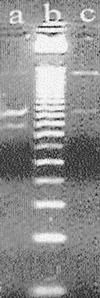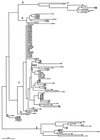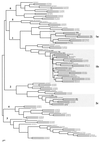Genomic and phylogenetic analysis of hepatitis C virus isolates from argentine patients: a six-year retrospective study
- PMID: 11101596
- PMCID: PMC87637
- DOI: 10.1128/JCM.38.12.4560-4568.2000
Genomic and phylogenetic analysis of hepatitis C virus isolates from argentine patients: a six-year retrospective study
Erratum in
- J Clin Microbiol 2001 Mar;39(3):1208-10
Abstract
Typing of hepatitis C virus (HCV) isolates from Argentine patients was performed by using different methodologies in a population of 243 patients. HCV subtype was assigned based upon restriction fragment length polymorphism (RFLP). HCV RNA genomes obtained from serum samples were classified as belonging to clade 1 (53.5%), 2 (23. 0%), or 3 (8.6%); 14.8% of samples showed HCV mixed infections, more frequently implying different subtypes within the same clade. In addition to RFLP typing, phylogenetic relatedness among sequences from both 5' untranslated region (n = 50) and nonstructural 5B coding region (n = 15) was established.
Figures




Similar articles
-
Comparative study of different methods to genotype hepatitis C virus type 6 variants.J Virol Methods. 2003 May;109(2):195-201. doi: 10.1016/s0166-0934(03)00071-5. J Virol Methods. 2003. PMID: 12711063
-
Genomic and phylogenetic analysis of hepatitis C virus strains from Argentina.Medicina (B Aires). 1998;58(2):153-9. Medicina (B Aires). 1998. PMID: 9706248
-
Determining hepatitis C genotype by analyzing the sequence of the NS5b region.J Virol Methods. 2003 May;109(2):187-93. doi: 10.1016/s0166-0934(03)00070-3. J Virol Methods. 2003. PMID: 12711062
-
Molecular epidemiology and putative origin of hepatitis C virus in random volunteers from Argentina.World J Gastroenterol. 2013 Sep 21;19(35):5813-27. doi: 10.3748/wjg.v19.i35.5813. World J Gastroenterol. 2013. PMID: 24124326 Free PMC article.
-
Genotypes of hepatitis C virus isolates from different parts of the world.Arch Virol Suppl. 1996;11:185-93. doi: 10.1007/978-3-7091-7482-1_16. Arch Virol Suppl. 1996. PMID: 8800799 Review.
Cited by
-
Phylogenetic Analysis and Epidemic History of Hepatitis C Virus Genotype 2 in Tunisia, North Africa.PLoS One. 2016 Apr 21;11(4):e0153761. doi: 10.1371/journal.pone.0153761. eCollection 2016. PLoS One. 2016. PMID: 27100294 Free PMC article.
-
Strategic approach to produce low-cost, efficient, and stable competitive internal controls for detection of RNA viruses by use of reverse transcription-PCR.J Clin Microbiol. 2007 Nov;45(11):3555-63. doi: 10.1128/JCM.02601-06. Epub 2007 Aug 15. J Clin Microbiol. 2007. PMID: 17699653 Free PMC article.
-
Hepatitis C virus infection in infants and children from Argentina.J Clin Microbiol. 2004 Mar;42(3):1199-202. doi: 10.1128/JCM.42.3.1199-1202.2004. J Clin Microbiol. 2004. PMID: 15004075 Free PMC article.
-
Phylodynamics of hepatitis C virus subtype 2c in the province of Córdoba, Argentina.PLoS One. 2011;6(5):e19471. doi: 10.1371/journal.pone.0019471. Epub 2011 May 18. PLoS One. 2011. PMID: 21611129 Free PMC article.
-
Genetic history of hepatitis C virus in Venezuela: high diversity and long time of evolution of HCV genotype 2.PLoS One. 2010 Dec 13;5(12):e14315. doi: 10.1371/journal.pone.0014315. PLoS One. 2010. PMID: 21179440 Free PMC article.
References
-
- Abrignani S, Rosa D. Perspectives for a hepatitis C virus vaccine. Clin Diagn Virol. 1998;15:181–185. - PubMed
-
- Buoro S, Pizzighella S, Boschetto R, Pellizzari L, Cusan M, Bonaguro R, Mengoli C, Caudai C, Padula M, Valensin P E, Palù G. Typing of hepatitis C virus by a new method based on restriction fragment length polymorphism. Intervirology. 1999;42:1–8. - PubMed
-
- Castillo I, Bartolome J, Quiroga J A, Carreño V. Comparison of several PCR procedures for detection of serum HCV-RNA using different regions of the HCV genome. J Virol Methods. 1992;38:71–79. - PubMed
Publication types
MeSH terms
Substances
LinkOut - more resources
Full Text Sources
Molecular Biology Databases

